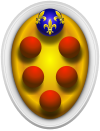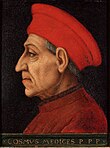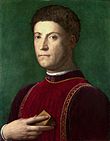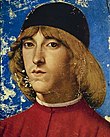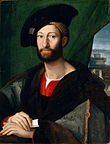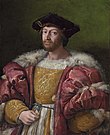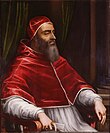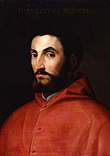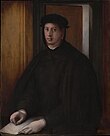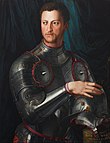
Florence is the capital city of the region of Tuscany in Central Italy. It is also the most populated city in Tuscany, with 360,930 inhabitants in 2023, and 984,991 in its metropolitan area.

The House of Medici was an Italian banking family and political dynasty that first consolidated power in the Republic of Florence under Cosimo de' Medici, during the first half of the 15th century. The family originated in the Mugello region of Tuscany, and prospered gradually until it was able to fund the Medici Bank. This bank was the largest in Europe during the 15th century and facilitated the Medicis' rise to political power in Florence, although they officially remained citizens rather than monarchs until the 16th century.

Piero di Lorenzo de' Medici, called Piero the Fatuous or Piero the Unfortunate, was the lord of Florence from 1492 until his exile in 1494.

Giovanni di Bicci de' Medici was an Italian banker and founder of the Medici Bank. While other members of the Medici family, such as Chiarissimo di Giambuono de' Medici, who served in the Signoria of Florence in 1401, and Salvestro de' Medici, who was implicated in the Ciompi Revolt of 1378, are of historical interest, it was Giovanni's founding of the family bank that truly initiated the family's rise to power in Florence. He was the father of Cosimo de' Medici and of Lorenzo the Elder; grandfather of Piero di Cosimo de' Medici; great-grandfather of Lorenzo de' Medici ; and the great-great-great-grandfather of Cosimo I de' Medici, Grand Duke of Tuscany.

Cosimo I de' Medici was the second Duke of Florence from 1537 until 1569, when he became the first Grand Duke of Tuscany, a title he held until his death.

The Republic of Florence, known officially as the Florentine Republic, was a medieval and early modern state that was centered on the Italian city of Florence in Tuscany, Italy. The republic originated in 1115, when the Florentine people rebelled against the Margraviate of Tuscany upon the death of Matilda of Tuscany, who controlled vast territories that included Florence. The Florentines formed a commune in her successors' place. The republic was ruled by a council known as the Signoria of Florence. The signoria was chosen by the gonfaloniere, who was elected every two months by Florentine guild members.
This article deals with the history of Tuscany.
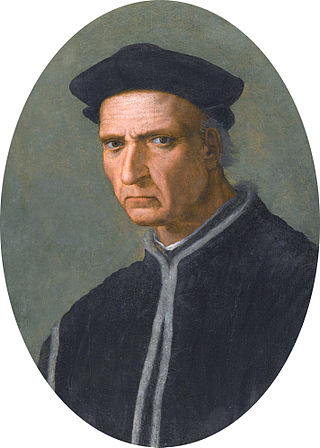
Piero di Tommaso Soderini, also known as Pier Soderini, was an Italian statesman of the Republic of Florence.
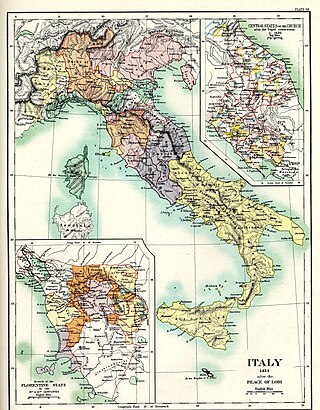
The Treaty of Lodi, or Peace of Lodi, was a peace agreement to put an end to the Wars in Lombardy between the Venetian Republic and the Duchy of Milan, signed in the city of Lodi on 9 April 1454.

The Albizzi family was a Florentine family originally based in Arezzo, who were rivals of the Medici and Alberti families. They were at the centre of Florentine oligarchy from 1382, in the reaction that followed the Ciompi revolt, to the rise of the Medici in 1434. They were active members of the Arte della Lana, Florence's wool guild. The Guilds played a central role in the governance of the Republic of Florence during the medieval period and guild members constituted Florence's political and economic oligarchy.
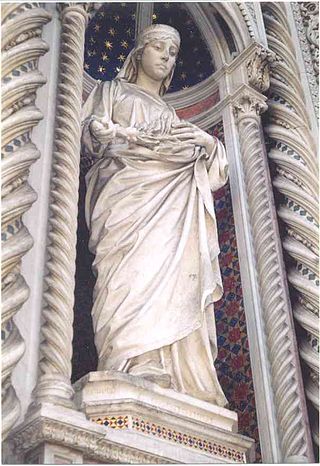
Florence weathered the decline of the Western Roman Empire to emerge as a financial hub of Europe, home to several banks including that of the politically powerful Medici family. The city's wealth supported the development of art during the Italian Renaissance, and tourism attracted by its rich history continues today.

The Duchy of Florence was an Italian principality that was centred on the city of Florence, in Tuscany, Italy. The duchy was founded after Pope Clement VII, himself a Medici, appointed his relative Alessandro de' Medici as Duke of the Florentine Republic, thereby transforming the Republic of Florence into a hereditary monarchy.

Giovanni Tornabuoni was an Italian merchant, banker and patron of the arts from Florence.

The Villa del Trebbio is a Medici villa in Tuscany, Italy.

Gonfaloniere of Justice was a post in the government of medieval and early Renaissance Florence. Like Florence's Priori, it was introduced in 1293 when Giano Della Bella's Ordinances of Justice came into force.

Bernardo Rucellai, also known as Bernardo di Giovanni Rucellai or Latinised as Bernardus Oricellarius, was a member of the Florentine political and social elite. He was the son of Giovanni di Paolo Rucellai (1403–1481) and father of Giovanni di Bernardo Rucellai (1475–1525). He was married to Nannina de' Medici, the elder sister of Lorenzo de' Medici, and was thus uncle to Popes Leo X and Clement VII, who were cousins. Oligarch, banker, ambassador and man of letters, he is today remembered principally for the meetings of the members of the Accademia platonica in the Orti Oricellari, the gardens of his house in Florence, the Palazzo Rucellai, where Niccolò Machiavelli gave readings of his Discorsi.
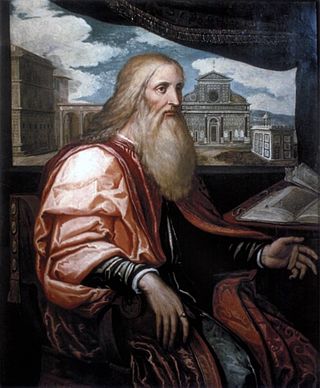
Giovanni Rucellai, known by his name with the patronymic Giovanni di Paolo Rucellai, was a member of a wealthy family of wool merchants in Renaissance Florence, in Tuscany, Italy. He held political posts under Cosimo and Lorenzo de' Medici, but is principally remembered for building Palazzo Rucellai and the Rucellai Sepulchre, for his patronage of the marble façade of the church of Santa Maria Novella, and as author of an important Zibaldone. He was the father of Bernardo Rucellai (1448–1514) and grandfather of Giovanni di Bernardo Rucellai (1475–1525).
The following is a timeline of the history of the city of Florence, Tuscany, Italy.

Guglielmo di Antonio de' Pazzi, Lord of Civitella was an Italian nobleman, banker and politician from the Republic of Florence. He was also husband of Bianca de' Medici, sister of the Lord of Florence Lorenzo the Magnificent.
